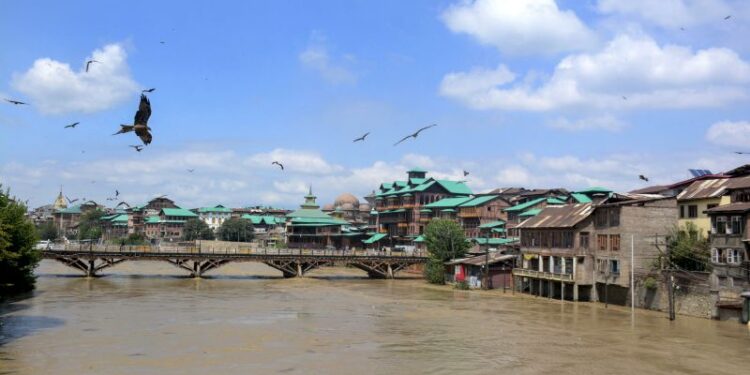CM asks officials reinforce flood-prone areas; calls for swift restoration of essential services
Srinagar: The flood situation in most parts of Kashmir eased on Friday as the water levels in the River Jhelum and other water bodies in the valley went below the danger mark in the wake of improvement in the weather, officials said.
There has been very little rainfall across the Kashmir valley in the past 24 hours, and the water levels in the River Jhelum, its tributaries, and other water bodies across the valley has started receding.
The water level in the Jhelum at Sangam in south Kashmir’s Anantnag district, as well as downstream in Srinagar’s Ram Munshibagh was below the danger mark, the officials said.
At other places as well, the water in the Jhelum is still above the danger mark but receding, they said, adding, close monitoring in such areas will continue.
All the tributaries of the Jhelum were flowing below the danger levels as well, the officials said, adding no breaches were reported along any part of the Jhelum overnight.
The water has also started receding in the areas that were inundated, though at some places such a situation remains, the officials said.
However, they said monitoring by various departments continued and such teams were on alert.
The officials said the water in the Wular Lake in north Kashmir’s Bandipora district was also receding and there was no need to panic.
They said preventive measures, including evacuation and shifting people to safer places, have been taken at all vulnerable spots.
In south Kashmir’s Anantnag district, several structures at many places along the banks of the Jhelum were damaged due to soil erosion in the aftermath of the floods.
Authorities have asked people to evacuate houses which have been damaged by flood waters in the Naidkhun Harnag areas of the district.
The Meteorological department has said the weather would stay mainly dry in J&K over the next 24 hours, with a possibility of light rain at one or two places.
However, as a precautionary measure, educational institutions across Kashmir remained closed for the third day on Friday to ensure the safety of students in the aftermath of the flood-like situation.
Meanwhile, Chief Minister Omar Abdullah on Friday ordered that the spots prone to flooding be reinforced and people stuck in villages be evacuated.
Chairing a meeting here, the chief minister directed swift restoration of essential services, such as power, water, and roads in the flood-hit areas.
“Chief Minister chaired a meeting today morning on the post-flood scenario and directed reinforcement of vulnerable spots, evacuation of people from inundated villages, round-the-clock monitoring through control rooms, and frequent visits to affected areas & timely advisories urging residents to stay alert, avoid panic & cooperate with administration,” his office said on X.
An official spokesperson said Abdullah also issued directions to counter rumour mongering.
The next 48 to 72 hours are “critical,” the chief minister said, according to him.
The statement quoted Abdullah saying, “The level of vigilance currently being maintained must continue until the water recedes below the danger mark. Our deployed teams must remain fully active on the ground, and continuous monitoring of bunds should be carried out. Any leakages or breaches must be addressed without delay.”
He added, “We cannot afford complacency.”
Abdullah asked all deputy commissioners to conduct realistic assessments of damage to property, agricultural lands, and infrastructure.
“These findings will form the basis for projecting requirements to the Government of India,” he said.
Abdullah announced Rs 5 crore from the UT CapEx budget, in addition to funds from the State Disaster Response Fund, towards food relief.
He also asked deputy commissioners and agriculture department officials to assess damage to standing crops across the two provinces.
The health department was asked to remain vigilant against potential water-borne and post-flood diseases.
At the meeting, Kashmir divisional commissioner briefed Abdullah on the water level at Sangam, Ram Munshi Bagh and Asham, saying that it has now receded below the danger mark, and water was also receding from villages in Shalina.
Essential supplies are being routed through Mughal Road, which has become the valley’s temporary lifeline after the blocking of the Srinagar-Jammu National Highway (NH-44), which is expected to be restored by Saturday, the spokesperson said.
Jhelum’s tributaries, including Lidder, Vaishow, Sandran, and Rambi Ara, were all seeing a decline in their water level, he said.







